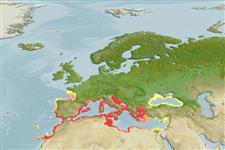Issue
Spicara flexuosa Rafinesque, 1810 is a valid species (Ref. 124120). Species page to be created.
Environment: milieu / climate zone / depth range / distribution range
Ökologie
seewasser; tiefenbereich 30 - 130 m (Ref. 7349). Subtropical; 47°N - 28°N, 19°W - 42°E
Eastern Atlantic: Portugal, Morocco, and Canary Islands including the Mediterranean and Black Sea.
Length at first maturity / Size / Gewicht / Alter
Maturity: Lm 11.5 range ? - ? cm
Max length : 25.0 cm SL Männchen/unbestimmt; (Ref. 6518); 21.0 cm SL (female)
Adults are found in the neritic zone, commonly over Posidonia beds and on sand, muddy and rock bottoms down to about 100 m (Ref. 6518, 124120). They are distributed at depths of 30m to 90m (Ref. 56124). Feed on zooplankton. Are protogynous hermaphrodites. A demersal spawner (Ref. 124120).
Sex reversal occurs at lengths over 10.9 cm TL in the northeastern Mediterranean (Ref. 93202). Also Ref. 103751.
Heemstra, P.C., 1990. Centracanthidae. p. 768-772. In J.C. Quero, J.C. Hureau, C. Karrer, A. Post and L. Saldanha (eds.) Check-list of the fishes of the eastern tropical Atlantic (CLOFETA). JNICT, Lisbon; SEI, Paris; and UNESCO, Paris. Vol. 2. (Ref. 7349)
IUCN Rote Liste Status (Ref. 130435)
Bedrohung für Menschen
Harmless
Nutzung durch Menschen
Fischereien: weniger kommerziell; Sportfisch: ja
Mehr Information
ReferenzenAquakulturAquakultur ProfilZuchtlinienGenetikElectrophoresesVererbbarkeitKrankheitenVerarbeitungNutrientsMass conversion
Tools
Zusatzinformationen
Download XML
Internet Quellen
Estimates based on models
Preferred temperature (Ref.
123201): 13 - 18.1, mean 14.5 °C (based on 87 cells).
Phylogenetic diversity index (Ref.
82804): PD
50 = 0.5039 [Uniqueness, from 0.5 = low to 2.0 = high].
Bayesian length-weight: a=0.01096 (0.00999 - 0.01203), b=3.03 (3.00 - 3.06), in cm total length, based on LWR estimates for this species (Ref.
93245).
Trophic level (Ref.
69278): 4.2 ±0.6 se; based on diet studies.
Generation time: 3.5 (2.3 - 6.1) years. Estimated as median ln(3)/K based on 11
growth studies.
Widerstandsfähigkeit (Ref.
120179): mittel, Verdopplung der Population dauert 1,4 - 4,4 Jahre. (K=0.24; tmax=5).
Prior r = 1.01, 95% CL = 0.66 - 1.51, Based on 1 stock assessment.
Fishing Vulnerability (Ref.
59153): Moderate vulnerability (40 of 100).
Climate Vulnerability (Ref.
125649): Moderate vulnerability (42 of 100).
Nutrients (Ref.
124155): Calcium = 97.2 [50.1, 179.3] mg/100g; Iron = 0.597 [0.192, 3.121] mg/100g; Protein = 19.7 [17.7, 21.8] %; Omega3 = 0.671 [0.324, 1.563] g/100g; Selenium = 16.4 [7.6, 33.8] μg/100g; VitaminA = 40.6 [12.6, 133.6] μg/100g; Zinc = 0.383 [0.147, 1.432] mg/100g (wet weight);
